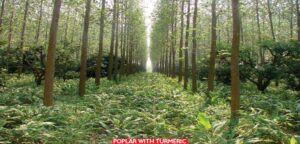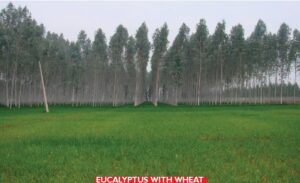
Agro forestry: Driving India’s Green and Brown Revolution
- September 7, 2024
- 0
Vision
In northern India, adventurous innovative farmers have embraced the cultivation of poplar and eucalyptus trees, which has been yielding more profits than the traditional agricultural crops. However, from 2011 to 2021, the expansion of trees outside forests (TOF) has been limited, with agroforestry practices accounting for only 5-6% of the geographical area in Punjab, Haryana, and western Uttar Pradesh. To develop Green Revolution Region into export hub of wood-based industries, the TOF coverage in this region must be increased to 10% of its geographical area by 2047 through the promotion of agroforestry.
While the wood panelling industry is well-established in the Yamunanagar region of Haryana, known as the plywood capital of India, it produces about one-third of the country’s panel products. Therefore, it is crucial to develop this area into an export hub for wood products derived from farm wood, with the aim of establishing ten clusters of wood-based industries in the region by 2047.

Current Status
The Green Revolution significantly increased wheat and paddy production, particularly in Punjab, Haryana, and western Uttar Pradesh. However, this surplus has led to several negative consequences, such as soil degradation, severe groundwater depletion and declining crop yields in these states. Additionally, issues related to the safety of grains from pests, inadequate grain storage and the high costs of transporting surplus grains to deficit regions of the country have become apparent. In response, the Government of India is promoting crop diversification and encouraging the cultivation of alternative crops like maize, millets, cotton, basmati rice, andtree crops.
According to the 2020 report “Trees Outside Forest Resources in India” by the Forest Survey of India, timber production from TOF in Haryana, Punjab, and Uttar Pradesh was 22 lakh cubic meters, 25 lakh cubic meters, and 75 lakh cubic meters, respectively. Following a favourable ruling by the Hon’ble Apex Court, the wood-based industry in Uttar Pradesh has rapidly expanded, leading to a decline in the supply of veneers and farm woods to the Yamunanagar market.
This timber scarcity has driven up the prices of eucalyptus and poplar wood (of girths 35 cm and above) to approximately Rs. 12,000/tonne and Rs. 15,000/tonne, respectively. Consequently, several plywood units have been forced to shut their businesses or operate below their operating capacity, with some relocating their machinery to other states including Bihar, Bengal, and Kerala and even to Nepal.

Furthermore, the establishment of Medium Density Fibreboard (MDF) units has been spurred by the growing demand for MDF due to its versatility, superior finishing, and carpenter-friendly workability. MDF, which is 25% cheaper than plywood, has become increasingly popular, driven by industry outreach and the easy availability of ready-made furniture. As a result, the use of MDF is expected to increase, leading to higher farm wood prices and a decline in plywood usage in the Indian market, aligning with international trends.
This transitional phase, expected to last two to three years, may lead to an increase in the area under tree crops, boosting the availability of farm wood. Moreover, integrating trees with agricultural crops can mitigate the damage caused by heat waves, necessitating the increase tree coverage.
The establishment of MDF plants that utilize smaller wood sizes (of girths less than 35 cm) will further encourage tree crop cultivation, potentially reducing the harvesting cycle to 2-3 years and lowering raw material costs to around Rs. 8,000/tonne. Therefore, the aggressive promotion of agroforestry on a larger scale in this region is essential to meet the timber demands of the wood panel industry at reasonable prices.
Promotion of Tree Farming
To stimulate the promotion of agroforestry, the Punjab Government has formulated a comprehensive plan that includes establishing a consortium of government bodies ensuring fair pricing for farm woods, creating cultivation agreements between farmers and industries, providing annuity payments through soft loans, developing infrastructure such as demonstration farms and an e-timber portal, engaging Punjab Agriculture University, Ludhiana for guidance and research, clearly dividing responsibilities between forest and agriculture departments, strengthening extension services, enforcing mandi laws, accrediting nurseries, and more.

Similarly, the Uttar Pradesh Government is implementing an ambitious greening plan that encompasses agroforestry and the establishment of MDF and large-sized plywood units. An inland container depot in Kalanaur is also under development to position Yamunanagar (Haryana) as a hub for promoting the export of wood panel products.
It is crucial to enhance R&D initiatives aimed at increasing the area under tree crop cultivation, which could help mitigate the impact of heat waves while also boosting farmland profitability. Additionally, promoting the cultivation of fruit and fodder trees alongside traditional agricultural crops will be key to gaining support from small and marginal farmers.
Conclusion
Expanding the area under tree crop cultivation will more than double wood production, driving the growth of wood-based industries, and creating employment and business opportunities. Apart from crop diversification, tree farming will improve soil quality, conserve the declining water table, enhance carbon sequestration, and mitigate the adverse effects of climate change, ultimately leading to a “Brown Revolution” in the nation’s food basket.
Some queries:
- What species are MDF plants and what’s their productivity in terms of income per unit area?
Ans. MDF plants use eucalyptus which is harvested at the age of 2-3 yrs whose net returns are Rs 50-60000/acre/yr. It is a socio-economic rotation which farmers practice due to their low holiday capacity. The profitability of 3-4 years plantations which is used in PW, is Rs 60-70000/acre/yr.
- Is there any report regarding decrease of food grains importantly cereals and millets mostly grown for staple food by farmers when they turn their lands to cultivation of agro forestry crops?
Ans. The trees occupy the space as well as cast shadows on agricultural crops, hence their production is always reduced, but agro forestry models are more profitable, requires less supervision, less labour intensive and less risky, hence adopted by farmers. As the productivity of agricultural crops is generally increasing hence the loss in production of agricultural crops due to agro forestry is accommodated.
- Is the increase in growing TOF species in the states you mentioned due to raising in fallow and lands owned by absentee landlords OR the cultivable lands converted for growing ToF?
Ans. Regarding use of lands, it is the owners decision to decide his land use of their farmlands which depends on their motives and convenience.
There is a lack of data in forestry sector; hence I will not be able to substantiate my observations with the corresponding reports.
👇 Please Note 👇
Thank you for reading our article!
If you don’t received industries updates, News & our daily articles
please Whatsapp your Wapp No. or V Card on 8278298592, your number will be added in our broadcasting list.



































































